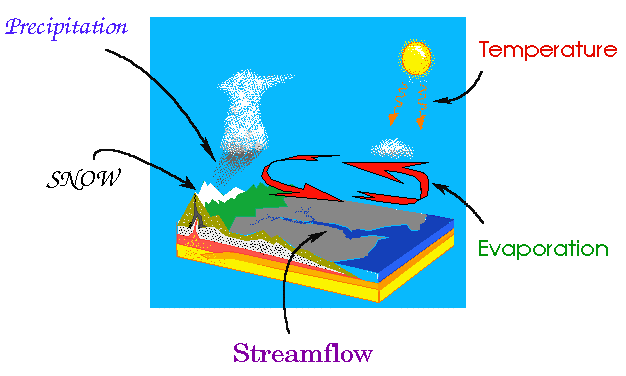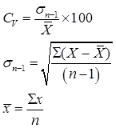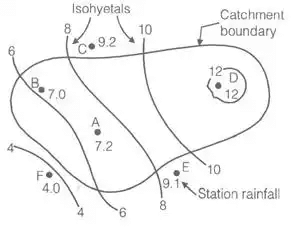Civil Engineering (CE) Exam > Civil Engineering (CE) Notes > Engineering Hydrology > Precipitation & Its Measurement
Precipitation & Its Measurement | Engineering Hydrology - Civil Engineering (CE) PDF Download
Precipitation & General aspects of Hydrology

- Index of Wetness
(i) Index of wetness = (rainfall in a given year at a given place /average annual rainfall of that place) x 100
(ii) % Rain deficiency = 100 - % index of wetness - Aridity index
A.I = (PET - AET / PET) x 100
Where, A.I = Aridity index
PET = Potential Evapo- transpiration
AET = Actual Evapotranspiration
(i) AI ≤ 0 → Nonarid
(ii) 1 ≤ A.I ≤ 25 → Mild Arid
(iii) 26 ≤ A.I ≤ 50 → Moderate arid
(iv) A.I > 50 → Severe Arid - Optimum Number of rain Gauge: (N)
N = (CV / ∈)2
where, Cv = Coefficient of variation,
∈ = Allowable % Error,
σ Standard deviation of the data, n = Number of stations, mean of rainfall value
mean of rainfall value - Estimation of missing rainfall data
(i)
If N1, N2…Nn < 10% of Nx
where, N1, N2,…Nx..Nn are normal annual precipitation of 1, 2,…x…n respectively.
P1, P2…Pn are rainfall at station 1, 2,…. N respectively.
And Px is the rainfall of station x.
Case: A minimum number of three stations closed to station ‘x’
(ii)
If any of N1, N2, N3…
Nn > 10% of Nx - Mean rainfall Data
To convert the point rainfall values at various into an average value over a catchment the following three methods are in use:
(i) Arithmetic Avg Method: when the rainfall measured at various stations in a catchment area is taken as the arithmetic mean of the station values.
Where, P1, P2…Pn are rainfall values
Of stations 1, 2…n respectively.
In practice this method is used very rerely.
(ii) Thiessen Polygon Method: in this method the rainfall recorded at each station is given a weightage on the basis of an area closest to the station.
Where, P1, P2…Pn are the rainfall data of areas A1, A2…An. The thiessen-polygon method of calculating the average precipitation over an area is superior to the arithmetic average method.
(iii) Isohyetal Method: An isohyet is a line joining points of equal rainfall magnitude. The recorded values for which areal average P is to be determined are then maked on the plot at appropirate stations. Neighbouring stations outside the catchment are also considered.

The document Precipitation & Its Measurement | Engineering Hydrology - Civil Engineering (CE) is a part of the Civil Engineering (CE) Course Engineering Hydrology.
All you need of Civil Engineering (CE) at this link: Civil Engineering (CE)
|
20 videos|36 docs|30 tests
|
FAQs on Precipitation & Its Measurement - Engineering Hydrology - Civil Engineering (CE)
| 1. What is precipitation and why is it important in hydrology? |  |
Ans. Precipitation refers to any form of water that falls from the atmosphere to the Earth's surface, such as rain, snow, sleet, or hail. It is an essential component of the hydrological cycle and plays a crucial role in hydrology as it replenishes water resources, including rivers, lakes, and groundwater. Precipitation also affects the distribution of water resources, influences weather patterns, and is a vital factor in climate studies and water resource management.
| 2. How is precipitation measured in hydrology? |  |
Ans. Precipitation can be measured using various instruments and techniques in hydrology. The most common method is using rain gauges, which are devices that collect and measure the amount of rainfall at a specific location. Rain gauges can be either manual or automated, and they provide data on the depth or intensity of precipitation. Other methods include weather radar, satellite remote sensing, and ground-based sensors, which provide more comprehensive and spatially distributed precipitation data.
| 3. What factors can affect the measurement of precipitation in hydrology? |  |
Ans. Several factors can influence the measurement of precipitation in hydrology. Some of these factors include wind, which can cause undercatch or overcatch in rain gauges, leading to inaccurate measurements. Evaporation can also affect the measurement, especially in areas with high temperatures or strong winds. The type of precipitation, such as snow or freezing rain, can pose challenges in measurement as well. Additionally, the location and placement of rain gauges can affect the representativeness of the measurements, as they need to be placed in open areas away from obstructions.
| 4. How is precipitation data used in hydrological modeling? |  |
Ans. Precipitation data is a crucial input for hydrological modeling, which is used to simulate and predict the behavior of water in various hydrological systems. The data is used to estimate the amount of water entering the hydrological system through rainfall or snowfall. This information is then used to determine the runoff, soil moisture, groundwater recharge, and streamflow, which are important parameters in hydrological models. Precipitation data is also used to validate and calibrate the models, ensuring their accuracy and reliability.
| 5. How does precipitation contribute to flood forecasting and water resource management in hydrology? |  |
Ans. Precipitation is a vital factor in flood forecasting and water resource management in hydrology. By monitoring and analyzing precipitation patterns, hydrologists can predict the likelihood and intensity of floods. Precipitation data is used to estimate the amount of water entering river systems, which helps in determining the response of rivers to rainfall events. This information is crucial for issuing flood warnings, implementing flood control measures, and managing water resources effectively. Precipitation data is also used to assess drought conditions, plan water allocation, and support decision-making processes in water resource management.

|
Explore Courses for Civil Engineering (CE) exam
|

|
Signup for Free!
Signup to see your scores go up within 7 days! Learn & Practice with 1000+ FREE Notes, Videos & Tests.
Related Searches

 mean of rainfall value
mean of rainfall value























